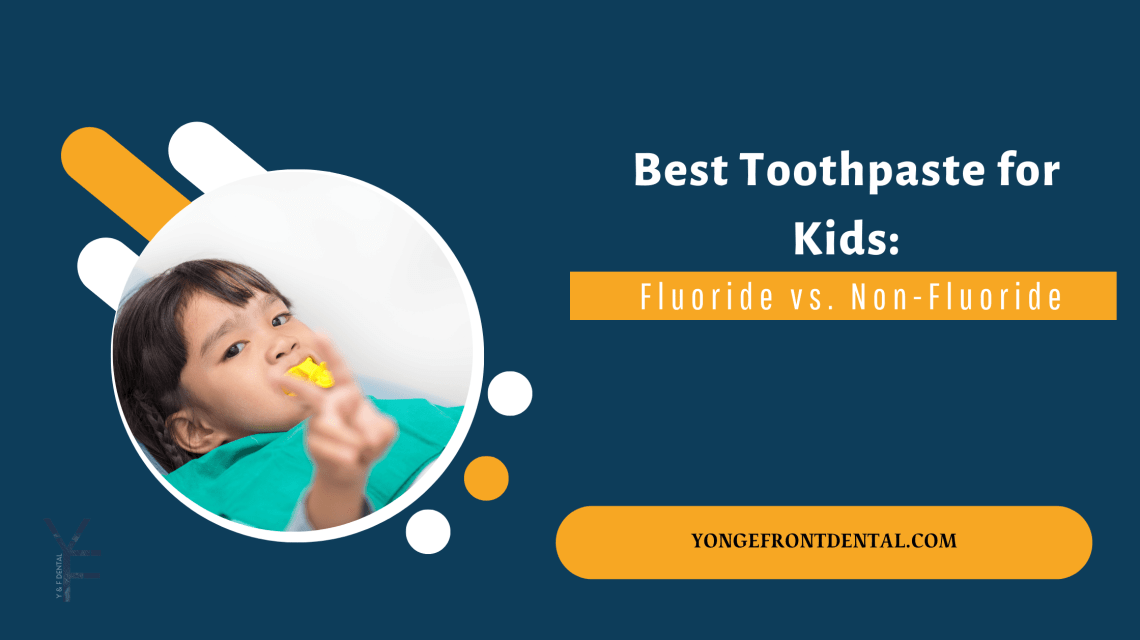Selecting the right toothpaste for your child is one of the many important decisions parents face in maintaining their little one’s health. With numerous options lining store shelves and conflicting advice from various sources, the choice between fluoride and non-fluoride toothpaste often leaves parents confused.
Best Toothpaste for Kids – Fluoride or Non-Fluoride?
At Yonge and Front Dental in Toronto, we understand this challenge and have created this comprehensive guide to help you make an informed decision for your child’s dental health.
Children’s Dental Needs
Children’s dental care requirements differ significantly from adults. Their developing teeth and growing mouths need special attention to establish a foundation for lifelong oral health.
Children face unique dental challenges including:
- Primary teeth vulnerability: Baby teeth have thinner enamel compared to permanent teeth, making them more susceptible to decay
- Developing brushing skills: Young children are still learning proper brushing techniques, often missing crucial areas
- Sweet dietary preferences: Many children consume more sugary foods and drinks, increasing cavity risk
- Swallowing reflexes: Younger children tend to swallow toothpaste rather than spitting it out
Dr. Sarah Chen, pediatric dental specialist at Yonge and Front Dental, explains: “Children’s oral health needs change dramatically as they grow. What works for a 2-year-old differs significantly from what a 7-year-old requires. Understanding these developmental stages helps parents make appropriate toothpaste choices.”
Regular dental check-ups remain essential regardless of your toothpaste choice. Professional cleanings, fluoride assessments, and early intervention for potential issues complement your at-home care routine.
What is Fluoride?
Fluoride is a naturally occurring mineral found in water sources, soil, and some foods. Since the 1940s, it has been widely recognized for its cavity-fighting properties and incorporated into dental products.
The science behind fluoride is well-established. When applied topically to teeth, fluoride:
- Strengthens tooth enamel by promoting remineralization
- Disrupts acid production by harmful oral bacteria
- Reverses early signs of tooth decay
- Creates a protective barrier against future acid attacks
The Canadian Dental Association and American Academy of Pediatric Dentistry support the use of appropriate amounts of fluoride for children, recognizing its significant role in reducing childhood cavities. However, the key phrase is “appropriate amounts” – the recommended fluoride concentration varies by age.

Fluoride Toothpaste for Kids: Benefits and Considerations
The primary advantage of fluoride toothpaste is its proven effectiveness in preventing tooth decay. Numerous clinical studies demonstrate that regular use of fluoride toothpaste can reduce cavities by 20-40% compared to non-fluoride alternatives.
Key Benefits of Fluoride Toothpaste
Fluoride toothpaste offers several important advantages for children’s dental health:
Cavity Prevention: Fluoride interferes with the ability of bacteria to produce decay-causing acids, helping prevent cavities before they start.
Enamel Reinforcement: Regular exposure to fluoride strengthens the outer layer of teeth, making them more resistant to acid attacks from plaque bacteria and sugary foods.
Repair Capabilities: Fluoride can help repair early tooth decay by promoting remineralization – the process of rebuilding weakened tooth enamel.
Long-Term Protection: When used consistently, fluoride toothpaste provides ongoing protection that significantly reduces the risk of developing serious dental problems.
Despite these benefits, some parents have concerns about fluoride use in children, particularly regarding:
Potential Concerns
Dental Fluorosis: Excessive fluoride ingestion during enamel formation (typically before age 8) can cause white spots or streaking on permanent teeth. This cosmetic condition doesn’t harm teeth but may be aesthetically undesirable.
Ingestion Risks: Very young children who haven’t mastered spitting often swallow toothpaste. While small amounts are safe, regular ingestion of larger quantities isn’t recommended.
Dr. Michael Wong from Yonge and Front Dental notes: “For most children, the benefits of fluoride toothpaste far outweigh the risks when used appropriately. The key is using the right amount and supervising brushing sessions.”
For children under 3 years, a rice-grain sized smear (approximately 0.1 mg fluoride) is recommended. Children 3-6 years should use a pea-sized amount (0.25 mg fluoride). Always supervise young children during brushing to minimize swallowing.

Non-Fluoride Toothpaste Options: Alternative Approaches
Non-fluoride toothpastes have gained popularity among certain parents who prefer alternative approaches to dental care. These products typically substitute other ingredients to provide cleaning and protection.
Common Ingredients in Fluoride-Free Formulations
Xylitol: This natural sweetener doesn’t just improve taste – research suggests it helps prevent bacteria from sticking to teeth and reduces acid production. Some studies indicate regular xylitol exposure can decrease cavity formation.
Hydroxyapatite: This mineral forms the primary component of tooth enamel. Nano-hydroxyapatite toothpastes aim to remineralize teeth by providing building blocks similar to natural tooth structure.
Natural Antibacterials: Ingredients like neem oil, tea tree oil, and coconut oil offer antimicrobial properties that may help control plaque bacteria without fluoride.
Calcium and Phosphate Compounds: These minerals support tooth remineralization through alternate pathways than fluoride.
Non-fluoride options may be particularly appropriate in certain situations:
- For very young children who consistently swallow toothpaste
- In areas with heavily fluoridated water, where additional fluoride might not be necessary
- For families following natural or holistic health approaches
- When children have specific sensitivities to fluoride products
However, it’s important to recognize that scientific evidence strongly favors fluoride toothpaste for cavity prevention. Non-fluoride alternatives generally show less consistent results in clinical studies, though research continues to evolve.
Making the Right Choice for Your Child
The best toothpaste choice depends on your child’s specific circumstances. Consider these factors when deciding between fluoride and non-fluoride options:
Age-Based Recommendations
Under 2 years: Consult your dentist. If recommended, use a rice-grain sized smear of low-fluoride (500-550 ppm) toothpaste.
Ages 2-6: A pea-sized amount of children’s fluoride toothpaste (1000 ppm), with supervision to ensure proper spitting.
Ages 6+: Regular fluoride toothpaste (1350-1500 ppm) with continued supervision until good habits are established.

Individual Risk Assessment
Children with higher cavity risk may benefit more from fluoride toothpaste. Risk factors include:
- History of previous cavities
- Poor diet high in sugary foods and drinks
- Inadequate brushing habits
- Limited access to dental care
- Certain medical conditions affecting saliva production
“At Yonge and Front Dental, we evaluate each child individually,” explains Dr. Jennifer Park. “For some children with high cavity risk, we might recommend additional fluoride measures beyond toothpaste. For others with low risk and excellent hygiene habits, non-fluoride options might be appropriate.”
Best Practices for Children’s Oral Hygiene
Regardless of which toothpaste you choose, proper technique remains crucial for effective dental care.
Effective Brushing Strategies by Age
Infants (pre-teeth): Gently wipe gums with a clean, damp cloth after feedings.
Babies (first teeth – 2 years): Use a soft infant toothbrush with a tiny smear of appropriate toothpaste. Brush gently in circular motions.
Toddlers and Preschoolers (2-5 years): Gradually teach brushing techniques, but continue to help. Make it fun with timers, songs, or brushing apps.
School-Age (6+ years): Supervise and check thoroughness. Electric toothbrushes can improve effectiveness for some children.
Creating Lasting Habits
Consistency forms the foundation of good oral health. Establish a twice-daily brushing routine that becomes second nature. Consider these approaches:
- Make brushing a non-negotiable part of morning and bedtime routines
- Use positive reinforcement rather than punishment for resistance
- Brush alongside your child to model proper behavior
- Use child-friendly tools like colorful toothbrushes or timers
- Focus on the process rather than perfection, especially with younger children
Remember that diet and lifestyle factors significantly impact dental health regardless of toothpaste choice. Limit sugary snacks, avoid sipping sweet drinks throughout the day, and encourage water consumption after meals.

When to Consult a Pediatric Dentist
Regular dental check-ups should begin by your child’s first birthday or when their first tooth appears. Beyond these routine visits, certain situations warrant additional professional consultation:
- White spots or lines on teeth
- Complaints of tooth sensitivity or pain
- Visible discoloration, chips, or irregularities
- Difficulty or resistance to brushing
- Concerns about bite alignment or spacing
At Yonge and Front Dental, our team specializes in creating positive dental experiences for children of all ages. From gentle introductory visits to comprehensive preventive care, we tailor our approach to each child’s developmental stage and comfort level.
Finding Balance: The Practical Approach
The fluoride versus non-fluoride decision doesn’t have to be all-or-nothing. Many families find success with balanced approaches:
- Using fluoride toothpaste in the evening (when cavity risk is higher) and non-fluoride in the morning
- Starting with non-fluoride options for very young children, then transitioning to appropriate fluoride use
- Combining non-fluoride toothpaste with professional fluoride treatments during dental visits
The most effective dental care plan is one that fits your child’s specific needs and your family’s values while addressing actual risk factors.
Conclusion
Choosing between fluoride and non-fluoride toothpaste represents just one aspect of your child’s comprehensive dental care. While scientific evidence strongly supports fluoride’s effectiveness in preventing cavities when used appropriately, other factors including brushing technique, diet, and regular dental visits play equally important roles.
At Yonge and Front Dental in Toronto, we partner with parents to develop individualized dental care plans for children at every developmental stage. We respect parental choices while providing evidence-based guidance to support optimal oral health outcomes.
Remember that dental care approaches can evolve as your child grows and their needs change. Regular professional assessments help ensure your current strategy continues to serve your child well.
To schedule a pediatric dental appointment or discuss specific concerns about your child’s dental care, contact Yonge and Front Dental at here . Our friendly team is ready to help your child develop a lifetime of healthy smiles.


